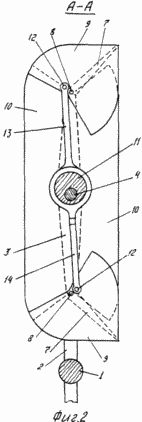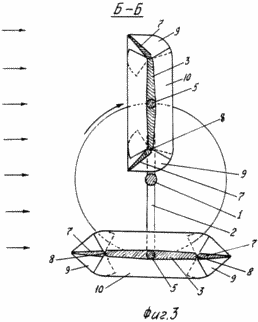| Start of section
Production, amateur Radio amateurs Aircraft model, rocket-model Useful, entertaining |
Stealth Master
Electronics Physics Technologies Inventions |
Secrets of the cosmos
Secrets of the Earth Secrets of the Ocean Tricks Map of section |
|
| Use of the site materials is allowed subject to the link (for websites - hyperlinks) | |||
Navigation: => |
Home / Patent catalog / Catalog section / Back / |
|
INVENTION
Patent of the Russian Federation RU2176328
![]()
HYDROTURBINE FOR RUSSIAN HYDRO-ELECTROSTATION
The name of the inventor: Chudikov NN
The name of the patent holder: Pyatigorsk State Pharmaceutical Academy
Address for correspondence: 357532, Stavropol Territory, Pyatigorsk, Kalinin Avenue, 11, PGPA
Date of commencement of the patent: 2000.02.14
The water turbine is designed to convert the energy of the water flow and can be used to generate electricity. The turbine contains a horizontal shaft and two rectangular blades capable of rotating around their axes parallel to the axis of the shaft, with an angular velocity half the angular velocity of rotation of the shaft, and in the direction opposite to the rotation of the shaft. Each blade is provided on the sides with two identical flaps capable of limited rotation around axes parallel to the axis of the blade, under the influence of an eccentric, connected to the flaps via the connecting rods, attached to the carrier coaxially with the blade, with an eccentricity directed along the carrier. The width of the flap is preferably 1/5 of the total width of the blade. The design of the turbine allows to increase power and efficiency.
DESCRIPTION OF THE INVENTION
The invention relates to the field of environmentally friendly and cheap energy, in particular to hydroturbines for channel HPP.
There are known hydroturbines for channel HPP (NM Shchapov "Turbine equipment of hydroelectric power stations", 3rd edition, 1961, p. 283).
Such hydro turbines are low-power and with low efficiency, therefore, for their use in channel hydroelectric power plants, they are practically unsuitable.
A hydroturbine is known for a channel HPP consisting of a horizontally located shaft and two rectangular blades capable of rotating about their axes parallel to the shaft with an angular velocity half the angular velocity of rotation of the shaft and directed to the side opposite the shaft. (Patent of the Russian Federation No. 2131994 of June 20, 1999). Such a hydroturbine, having a certain quality, has insufficiently high efficiency.
The object of the present invention is to improve the efficiency of a hydroturbine for a channel HPP.
This goal is achieved by the fact that each turbine blade has two identical flaps on the sides that are able to rotate about the axes parallel to the axis of the blade, under the influence of an eccentrically connected eccentric attached to the carrier coaxially with the blade, with an eccentricity directed along the carrier, And from both ends of the blade and flaps perpendicular to the axis of the blade plates are fixed, the total width of the blade together with the flaps more than twice the distance from the edge of the shaft to the axis of rotation of the blade.
 |
 |
 |
The essence of the invention is explained by the drawing, where in FIG. 1 shows a general view of a hydroturbine; In Fig. 2 - section AA; In Fig. 3 - section B-B.
The hydraulic turbine consists of a shaft 1 with the carriers 2 fixed on it, at whose ends the blades 3 are mounted, by means of the semiaxis 4 (Figures 1-3). The blades are reinforced by the spars 5. The shaft 1 is located horizontally on the supports 6. On the sides of each blade there are two identical flaps 7, capable of simultaneously rotating together around the axes 8 parallel to the axis of the blade to either side of the plane of the blade. At both ends of the blade and flaps, plates 9 and 10 are fixed in a position perpendicular to the axis of the blade. The eccentric 11 with eccentricity directed along the drivers is fixed to the blades coaxially to the blades. Axis 4 of the blade passes through the eccentric, and on the plates 9 of the flaps fixed axles 12, on which the connecting rods 13 and 14 are fixed. The other ends of the connecting rod sit on the eccentric. This connection of flaps with an eccentric is possible from both ends of the blade. The blade width without flaps is preferably equal to the width of the three flaps.
The total width of the blade with flaps is more than twice the distance from the edge of the shaft to the axis of rotation of the blade.
The preferred flap deflection is up to 30 ° .
The turbine works as follows. In the presence of water flow, as indicated by arrows (Figure 3), the hydraulic turbine will rotate under the influence of the water flow on the blade. At the beginning of the turn of the turbine, when the plane of the blade above the shaft coincides with the vertical plane passing through the axis of the shaft (Figures 1-3), the blade (thanks to flaps, plates, eccentric and connecting rods) assumes a cup-shaped shape formed by plates 9 and 10 , Deflected in one direction against the flow by flaps (Figures 2 and 3). With further rotation of the hydroturbine, the depth of the bowl-blade decreases and when the turbine is rotated by 180 °, the flaps are aligned with the plane of the blade 3, taking a streamlined shape. With each revolution, the turbine's turbines rotate to the flow with the other side, so the flaps are always deflected towards the flow.
Thus, taking a cup-like shape, the blade perceives itself and transmits to the shaft not only the force of the direct impact of the water flow, but also the additional pressure that it creates inside the bowl on its walls. Thus, this hydroturbine catches most of the energy of the water flow, which increases its efficiency and efficiency. When three such blades are used, the power and efficiency of such a turbine increases significantly.
An essential feature of the present invention is that the blades have flaps kinematically connected via connecting rods with eccentrics attached to the carriers, and plates are fixed at the ends of the blades and flaps. The advantage of the proposed design is a significant increase in power and efficiency of the turbine.
CLAIM
1. A hydroturbine for a channel HPP consisting of a horizontally located shaft and two rectangular blades with a maximum working surface that can rotate about their axes parallel to the axis of the shaft with an angular velocity half the angular velocity of rotation of the shaft and in the direction opposite to the shaft , Characterized in that each blade has two identical flaps on the sides, capable of being rotationally limited to rotate about axes parallel to the axis of the blade, under the action of an eccentric, connected to the flaps through the rods, attached to the carrier coaxially with the blade, with an eccentricity directed along the carrier, The flap is preferably 1/5 of the total width of the blade.
2. A turbine according to claim 1, characterized in that at the ends of the blade and flaps perpendicular to the axis of the blade plates are fixed, the total width of the blade together with the flaps being more than twice the distance from the edge of the shaft to the axis of rotation of the blade.
print version
Date of publication 12.01.2007gg




Comments
When commenting on, remember that the content and tone of your message can hurt the feelings of real people, show respect and tolerance to your interlocutors even if you do not share their opinion, your behavior in the conditions of freedom of expression and anonymity provided by the Internet, changes Not only virtual, but also the real world. All comments are hidden from the index, spam is controlled.